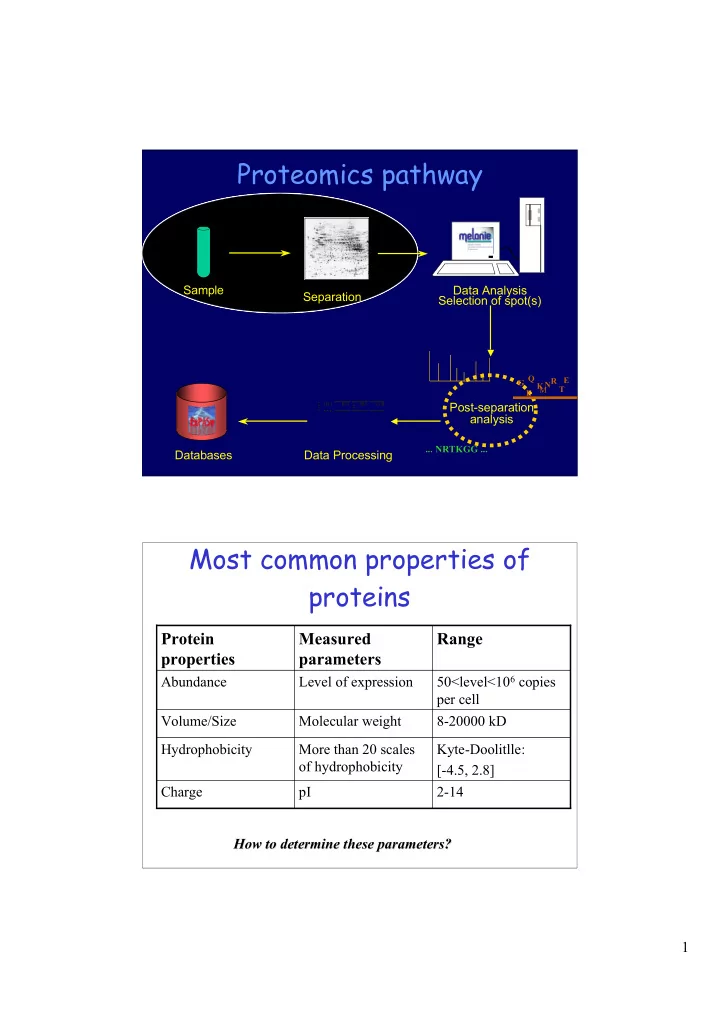

Proteomics pathway Sample Data Analysis Separation Selection of spot(s) G Q R E N K T M E Post-separation analysis ... NRTKGG ... Databases Data Processing Most common properties of proteins Protein Measured Range properties parameters Abundance Level of expression 50<level<10 6 copies per cell Volume/Size Molecular weight 8-20000 kD Hydrophobicity More than 20 scales Kyte-Doolitlle: of hydrophobicity [-4.5, 2.8] Charge pI 2-14 How to determine these parameters? How to determine these parameters? 1
Protein analysis Samples => Complex proteins mixtures Protein separation before identification procedure Electrophoretical Liquid separations chromatography Gel Capillary Hydrophobicity Ionic strength M r pI pI/ M r M r pI CZE ≈ M r But also: Immuno-selectivity Affinity capture Multidimensional chromatography Source: Willy Bienvenut Sample preparation Objetive : to allow an efficient separation of the greater number of Objetive proteins in two dimensions. This procedure is very important and must This procedure is very important and must: : • Solubilise as many proteins as possible including hydrophobic species • Prevent protein aggregates and hydrophobic interactions . This includes denaturing the proteins to break non-covalent interactions, to break disulfide bonds and to disrupt non-covalent interactions between proteins and other compounds, such as lipids or nucleic acids • Remove or digest any RNA or DNA, coenzymes, hormones or anything else in the cell that could interfere with the proteins separation 2
Sample preparation (cont.) Sample preparation (cont.) To overcome some of these problems : to increase the number of low abundance proteins, two alternative approaches of enrichment of rare polypeptides may be used: Subcellular fractionation and protein prefractionation. separate membrane proteins, nucleole, cytoplasmic, cytosolics, etc. Specific reagents to increase solubility of hydrophobic proteins. Specific reagents to break disulfid bonds. Enzymatic digestion of DNA and ultracentrifugation. 3
Gel free approach • Sub cellular fractionation: – Differential centrifugation, – Mechanical techniques… • Chromatographic approach: – Ion exchange (cation or anion) – Gel filtration – Affinity • Proteins precipitation: – Acetone, – Ammonium sulfate… Sample pre-fractionation http://www.chem.uwec.edu/Chem352_S03/Pages/Overheads/C352_lect6_view.pdf 4
Chromatography • Separation technique that depends on differential affinity for a mobile and a stationary phase: – For protein isolation, the mobile phase is usually an aqueous solution – The stationary phase is attracted to a physical property of the protein: • Ion exchange – net charge • Reverse phase – hydrophobicity • Gel filtration - size • Affinity – ligand binding http://www.chem.uwec.edu/Chem352_S03/Pages/Overheads/C352_lect6_view.pdf Gel free separation http://www.chem.uwec.edu/Chem352_S03/Pages/Overheads/C352_lect6_view.pdf 5
Gel-filtration Chromatography http://www.chem.uwec.edu/Chem352_S03/Pages/Overheads/C352_lect6_view.pdf Affinity Chromatography http://www.chem.uwec.edu/Chem352_S03/Pages/Overheads/C352_lect6_view.pdf 6
Electrophoresis technique First dimension : First dimension pH 10 3 Cathode (-) Anode (+) electric + + field + Basic tampon + sample R - COOH + OH - R - COO - + H 2 O R - NH 2 + OH - R - NH 2 + OH - pH 3 10 Anode (+) Cathode (-) electric + + field + Acid tampon + sample R - COOH + H 3 O + R - COOH + H 3 O + R - NH 2 + H 3 O + R - NH 3 + + H 2 O First dimension: Isoelectric focusing 7
2-D PAGE Second dimension Isofocalisation Between first and second dimensions, there is an equilibrium First dimension phase necessary to: Cathode (-) • eliminate products of the initial gel (ampholytes) Second dimension • resolubilise the proteins and • charge the proteins with SDS. Anode (+) SDS-PAGE: molecular weight separation on polyacrylamide gel See: http://www.rit.edu/~pac8612/electro/Electro_Sim.html 8
1-DE separation of proteins (by M r ) Std Gel A Gel B Std (M r en KDa) 1 2 3 4 5 6 (M r en KDa) 150 KDa 120 KDa PHS2 (98 KDa) BSA (65 KDa) OVAL (45 KDa) PHS2 (98 KDa) BSA (65 KDa) CAH2 (31 KDa) ITRA (24 KDa) OVAL (45 KDa) LYC (14 KDa) 30 KDa 10 KDa Gel A: 12% Acrylamide, Gel B: 8% Acrylamide, Nucleolar protein separation after coomassie blue staining http://www.expasy.org/cgi-bin/map2/def?NUCLEOLI_HELA_1D_HUMAN 2-DE separation of proteins (by Mr) pH pH Second dimension = molecular weight (Mw) Human liver proteins Human serum proteins separated by 2-DE , silver stained separated by 2-DE, silver stained 9
IPG with sigmoidal pH Ecoli Ecoli 3.5 - 10 pH 3.5 - 10 pH 3 - 10 linear rule 3 - 10 linear rule Final dimensions: 160 x 200 x 1.5 mm, loading capactiy 5 mg of proteins Final dimensions: 160 x 200 x 1.5 mm, loading capactiy 5 mg of proteins IPG with 1 or 2 pH unities Swiss 2DPAGE: Swiss 2DPAGE: Ecoli 3.5-10, Ecoli 4-5, Ecoli 4.5-5.5, Ecoli 5-6 Ecoli 3.5-10, Ecoli 4-5, Ecoli 4.5-5.5, Ecoli 5-6 Final dimensions: 160 x 200 x 1.5 mm, loading capactiy 15 mg of proteins Final dimensions: 160 x 200 x 1.5 mm, loading capactiy 15 mg of proteins 10
Staining Once separated, the proteins must be detected over the gel to then be called a proteome map. Many different colorants: Coomassie blue staining Amido black staining Silver staining Fluorescence Autoradiography ou fluorography Silver nitrate Commassie blue Source Dr. Jean-Charles Sanchez, LCCC, Geneva 11
Analytic 2-D PAGE Technically, these are the following steps : Sample preparation First dimension with IPG Second dimension with SDS-PAGE Fixation of proteins on the gel Proteins detection with staining Preparative 2-D PAGE Technically, these are the following steps : Sample preparation First dimension with IPG Second dimension with SDS-PAGE Transfer to PVDF membrane Proteins binding on the membrane Proteins detection with staining over PVDF membrane 12
Transfer to PVDF membrane PVDF = Polyvinylidene difluoride membrane Thin as a paper sheet (100 µ m): a more efficient means of storage (proteins are dried). proteins are even more concentrated. specially when proteins are designated to sequencing, amino acid composition and mass spectrometry. Protein identification from gel electrophoresis Electroblotting Protein on the Protein in the Gel membrane Image analysis Image analysis Spot cutting for MS analysis & Gel matching Edman analysis Spot cutting for MS analysis Protein immunodetection Electroelution of the proteins AA composition analysis Willy Bienvenut 13
Recommend
More recommend